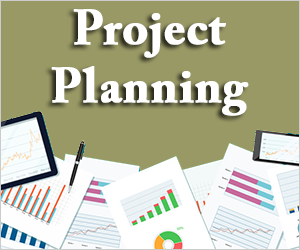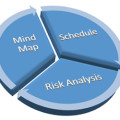
Project planning is immensely underrated. Everyone has a story of how they could have planned better to avoid a disaster, even if they didn’t look back and realise it.
The Project Management Institute suggests that planning should ideally consist of about 20 – 30% of the time required to perform the project work. This is substantially more than most project managers actually spend on project planning. But the additional planning will negate project issues that cause missed deadlines, increase costs, and decrease project success.
Project planning should ideally consist of the following 5 steps:
- Determine Stakeholders. Most projects have one primary stakeholder for whom the work is being done, and everyone knows about them are and what their needs are. But it’s the smaller secondary stakeholders who have a small, highly specific interest in the project but disproportionately large ability to derail it. They all need to be identified.
- Establish project goals. Likewise, every project has a primary goal, for example to produce a prototype or construct a structure. But there are usually many secondary goals like keeping certain stakeholders satisfied (think government regulatory agencies), finishing within budget or ahead of schedule, or securing more work.
- Create the Scope Statement. The scope defines the project. It establishes the boundaries, and it is thus one of the first things that need to be done.
- Divide the project into tasks. The Work Breakdown Structure, or task list, is one of the fundamental aspects of the project management, and many other tasks depend on it.
- Create the schedule. Professional project scheduling requires that each task be given start and finish dates and a budget. Then, a network diagram determines the critical path and floats, which allows an initial schedule to be produced. Lastly, resource levelling determines where, within their floats, each task is ideally placed.
- Create the Project Management Plan. The other parts of a project management plan are detailed below.
During the project, effective project control requires a schedule that contains, as a minimum, a breakdown of tasks and:
- Task start and finish dates.
- Task budgets.
Against this baseline, earned value management is used for the early detection of schedule and cost variances from the plan. But the data is only as good as the plan. Knowing you’re ahead or behind schedule (or cost) is not effective if the schedule you’re measuring against is weak.
Project planning is the second out of five process groups in the Project Management Body of Knowledge, and it has one major deliverable: The Project Management Plan. This is the guiding document for a project manager which lays out to the stakeholders how the project will be managed.
The Project Management Plan
For large projects, such as in the oil patch or industrial sectors, a living project management plan is used by professional project managers to set up the project plan and manage stakeholders’ expectations. It “guides the ship.” For the millions of small projects where project managers are technical people, or inexperienced with project management theory, I would suggest that a project management plan is even more important. Missed deadlines and cost changes are epidemic in our project-based world, and this problem would be solved with simple adherence to project management theory.
In fact, a project manager’s competence could be judged by the quality of their project management plan.
All ten of the Project Management Body of Knowledge’s knowledge areas are represented in it. The project management plan is the master plan for the project and contains all of the information necessary to acquire and manage the resources to complete the finished product.
Parts of a Project Management Plan
It is important to state that all information that is necessary to define and manage the project should be part of a project management plan. There is no definitive template, although there are standard parts. The following is not an exhaustive list, and any other item that is necessary for a successful project should be included in it.
- Critical Success Factors. What defines project success? Usually there is a primary factor, like building a bridge that carries the structural loads, but what about the secondary things like maintaining a strong relationship with a key project sponsor that could secure future projects.
- Scope Statement. This is foundational as it defines the project and attempts to delineate its boundaries. It states what work is part of the project and what is not.
- Deliverables. A list of what the project will produce as its end results, as well as the intermediate results, internal or external. Any overall criteria built in to the project, like size, shape, grade, or functionality can be explicitly defined here.
- Budget. Since projects have a defined beginning and end, there must be a defined budget and schedule. Putting the budget into the project management plan is a great way to communicate what it is. Sometimes people even make assumptions of the scope when they don’t see a number. It’s also good to lay bare any conditions of project funding or potential budget changes and why/how they could occur.
- Schedule. If possible, a graphical bar (gantt) chart works really well. For ultra-small projects a deadline might suffice, with intermediate milestones if necessary. Regardless of the level of detail, a schedule shows what the project plan is and when work will be accomplished.
- Quality. In almost every industry, standards exist on which the deliverables can be judged, such as ISO, ASTM, or IEEE. Often the owner/client has standards for projects they run. Other quality criteria like expert reviews can be documented.
- Communication. Almost all projects have some sort of standard communication requirements which can be defined and planned for. These include progress updates, technical briefs, investor circulars, and the like. Maybe you intend to take a project sponsor for lunch monthly until the project is complete. If that’s what it takes to get the project done right, it should be defined in the communications plan.
- Risk. In this section the risks to the project’s critical success factors are listed and prioritized, and contingency plans are drawn up for those risks that are considered important enough to warrant it.
- Project Control. Project management plans can be relegated to the bookshelf if you don’t put a priority on opening it and using it. It’s good to have a section for identifying how the project will be controlled to ensure it doesn’t drift out of its scope, budget, or any other factor.






